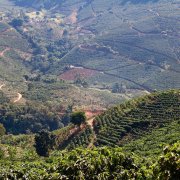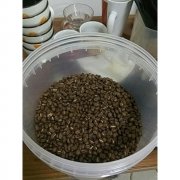Starbucks played the iron board here-- Costa Rican coffee.
For professional baristas, please follow the coffee workshop (Wechat official account cafe_style)
In Costa Rica, as in Taiwan, you can see all the famous fast food chains, McDonald's and KFC,Pizza Hut, but there is one restaurant that you haven't seen (I dare not say there are none at all). But at least I don't see it where I'm going. Starbucks, I believe, is not only in Costa Rica, but throughout Central America, because people here have a long history of drinking coffee, they are very particular about coffee, they have a good taste in coffee, and people produce their own coffee, so the so-called "coffee processing" like Starbucks in the United States. Shop ", probably not in their eyes, can only go around in the United States and Asia, because we don't know how to taste coffee at all, just like when we watch the French and the British drink tea with sugar and milk, they feel that they are crazy. The art of drinking tea is the same.
My colleague pointed out to me in a local restaurant that this is their original coffee maker, which is still in use today. A wooden shelf with a hole in the middle and a funnel-shaped cloth bag. Put the ground coffee powder in, then inject hot water, put a cup underneath, and then, that fragrance, ah, is completely different from using a coffee machine, and then I think that although traditional things may not be very efficient, but things that need to be made over a long period of time, sometimes there is a beauty that people can taste with their spare time.
When I get to Costa Rica, I have to visit the place where they grow coffee trees and the factories that make coffee; this is very new to me. I am not a coffee drinker, and I know almost nothing about coffee, but I really learned a lot during this trip to the coffee factory.
I have never seen a coffee tree. I have never seen the fruit of a coffee tree. Of course, I have never tasted the coffee fruit that has just been picked. In more familiar words, it is the "coffee" version of "I have eaten pork and I have never seen a pig walk".
The coffee beans we are familiar with are the seeds in the middle of the coffee fruit. The coffee fruit is red when it is ripe. After peeling off the red skin, there is a thin and transparent pulp inside, which tastes sweet. After the factory peels the coffee fruit with a machine, it can be placed in the dryer for 24 hours. Of course, it can also be left outside and basked in the sun in the traditional way, which takes six to eight days. After the coffee beans are completely dry, they will have to be kept in sacks for three months. interestingly, the tour guide told us that 70% of the first-grade coffee beans in this factory are sold to Starbucks.
Coffee beans that are completely dry and put in gunny bags for three months can be baked. The longer the coffee beans are roasted in the roaster, the darker the color, and the stronger the coffee is. European coffee is generally very light and takes 15 minutes. French coffee takes 17 minutes, and the strongest Italian coffee has to be roasted for 25 to 30 minutes. Most people have the wrong common sense that the stronger coffee contains more caffeine, in fact, all coffee contains the same caffeine, the length of roasting time can only change the smell of coffee, and the so-called decaffeinated coffee, there is no way to make it here, they ship the beans to Germany for processing, but although they claim to be "decaffeinated" coffee Contains a very small amount of caffeine more or less.
Coffee beans are planted in the field, usually two beans together, because it competes with each other and supports each other, which is better than coffee trees grown from a single bean, and coffee trees are mostly planted in areas surrounded by other fruit trees. the most common of these fruit trees are banana trees and orange trees, which protect coffee trees from the wind. It takes two and a half to three years for coffee trees to pick their first fruit. For more than 25 years, although they can still produce coffee, the quality is poor and needs to be replanted. November to February of each year is the harvest season for coffee. Up to now, in Costa Rica, coffee is harvested manually.
After getting to know a little coffee, holding a cup of coffee in my mouth seems to be different.
Important Notice :
前街咖啡 FrontStreet Coffee has moved to new addredd:
FrontStreet Coffee Address: 315,Donghua East Road,GuangZhou
Tel:020 38364473
- Prev

Costa Rican coffee bean varieties Tara Beads coffee bean classification grading criteria
Weixin Official Accounts cafe_style) This is one of Costa Rica's coffee-growing areas in the Orosi Valley) About Costa Rica Coffee Beans (Central America) Costa Rica Tarrazu is one of the largest coffee-growing areas in the world. It is located in the central valley of Costa Rica and is also located in San Jose, the capital of the country
- Next

Vessie Honey West Arsi Ethiopia washed Sidamo Coffee beans Vessie Honey details
Professional baristas exchange please pay attention to the coffee workshop (Wechat official account cafe_style) Vishi honey G1 Ethiopia washed Sidamo Ethiopia imported coffee raw beans washed Sidamo Vishi honey West Arsi G1 basic information production area: Ethiopian Oromia species: Ethiopian native species Haiba: 2000 species of growers: treatment: washing wind
Related
- Detailed explanation of Jadeite planting Land in Panamanian Jadeite Manor introduction to the grading system of Jadeite competitive bidding, Red bid, Green bid and Rose Summer
- Story of Coffee planting in Brenka region of Costa Rica Stonehenge Manor anaerobic heavy honey treatment of flavor mouth
- What's on the barrel of Blue Mountain Coffee beans?
- Can American coffee also pull flowers? How to use hot American style to pull out a good-looking pattern?
- Can you make a cold extract with coffee beans? What is the right proportion for cold-extracted coffee formula?
- Indonesian PWN Gold Mandrine Coffee Origin Features Flavor How to Chong? Mandolin coffee is American.
- A brief introduction to the flavor characteristics of Brazilian yellow bourbon coffee beans
- What is the effect of different water quality on the flavor of cold-extracted coffee? What kind of water is best for brewing coffee?
- Why do you think of Rose Summer whenever you mention Panamanian coffee?
- Introduction to the characteristics of authentic blue mountain coffee bean producing areas? What is the CIB Coffee Authority in Jamaica?

